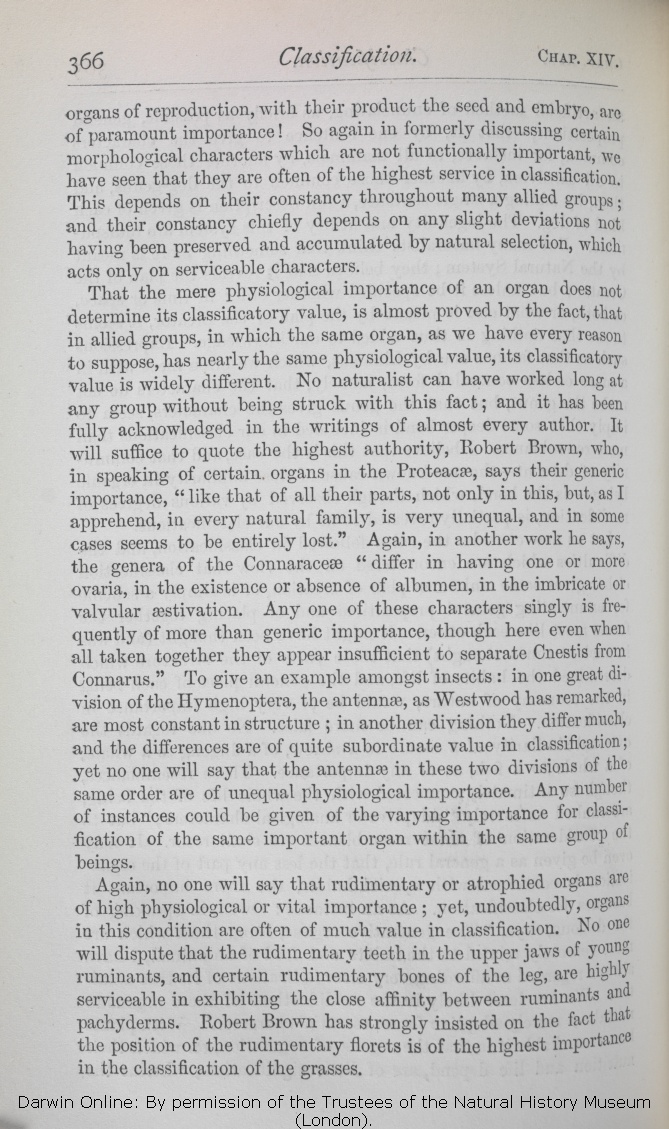whereas the organs of reproduction, with their product the
seed | seed 1869 1872 | | seed, 1859 1860 1861 1866 |
| and embryo, are 1869 1872 |
| are 1859 1860 1861 1866 |
| characters 1872 | | differences 1869 |
| functionally 1872 | | physiologically 1869 |
| chiefly depends 1872 | | depends chiefly 1869 |
| not 1872 |
| of structure in such parts not 1869 |
| serviceable 1872 | | useful 1869 |
| 4 blocks not present in 1869 1872; present in 1859 1860 1861 1866 | | We must not, therefore, in classifying, trust to resemblances in parts of the organisation, however important they may be for the welfare of the being in relation to the outer world.
Perhaps from this cause it has partly arisen, that almost all naturalists lay the greatest stress on resemblances in organs of high vital or physiological importance.
No doubt this view of the classificatory importance of organs which are important is generally, but by no means always, true.
But their importance for classification, I believe, depends on their greater constancy throughout large groups of species; and this constancy depends on such organs having generally been subjected to less change in the adaptation of the
species to their conditions of life.
|
|
That the mere physiological importance of an organ does not determine its classificatory value, is almost
proved | proved 1872 | | shown 1859 1860 1861 1866 |
| ..... 1872 | | one 1859 1860 1861 1866 |
| long at 1872 | | at 1859 1860 1861 1866 |
| ..... 1860 1861 1866 1872 | | most 1859 |
| who, 1866 1872 | | who 1859 1860 1861 |
| Proteacæ, 1872 | | Proteaceæ, 1859 1860 1861 1866 |
| this, 1861 1866 1872 | | this 1859 1860 |
| Again, 1866 1872 | | Again 1859 1860 1861 |
| insects: 1866 1872 | | insects, 1859 1860 1861 |
| much, 1859 1860 1861 1872 | | much 1866 |
| ..... 1872 | | probably 1859 1860 1861 1866 |
| 7 blocks not present in 1859 1860 1861 1866 1872; present in 1869 | | That the mere physiological importance of an organ does not determine its classificatory value, is almost proved by the fact, that in allied groups, in which the same organ, as we have every reason to suppose, has nearly the same physiological value, its classificatory value is widely different.
No naturalist can have worked at any group without being struck with this fact; and it has been fully acknowledged in the writings of almost every author.
It will suffice to quote the highest authority, Robert Brown, who, in speaking of certain organs in the Proteaceæ, says their generic importance, "like that of all their parts, not only in this, but, as I apprehend, in every natural family, is very unequal, and in some cases seems to be entirely lost."
Again, in another work he says, the genera of the Connaraceæ "differ in having one or more ovaria, in the existence or absence of albumen, in the imbricate or valvular æstivation.
Any one of these characters singly is frequently of more than generic importance, though here even when all taken together they appear insufficient to separate Cnestis from Connarus."
To give an example amongst insects: in one great division of the Hymenoptera, the antennæ, as Westwood has remarked, are most constant in structure; in another division they differ much, and the differences are of quite subordinate value in classification; yet no one will say that the antennæ in these two divisions of the same order are of unequal physiological importance.
Any number of instances could be given of the varying importance for classification of the same important organ within the same group of beings.
|
|









